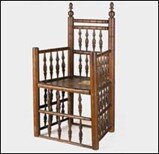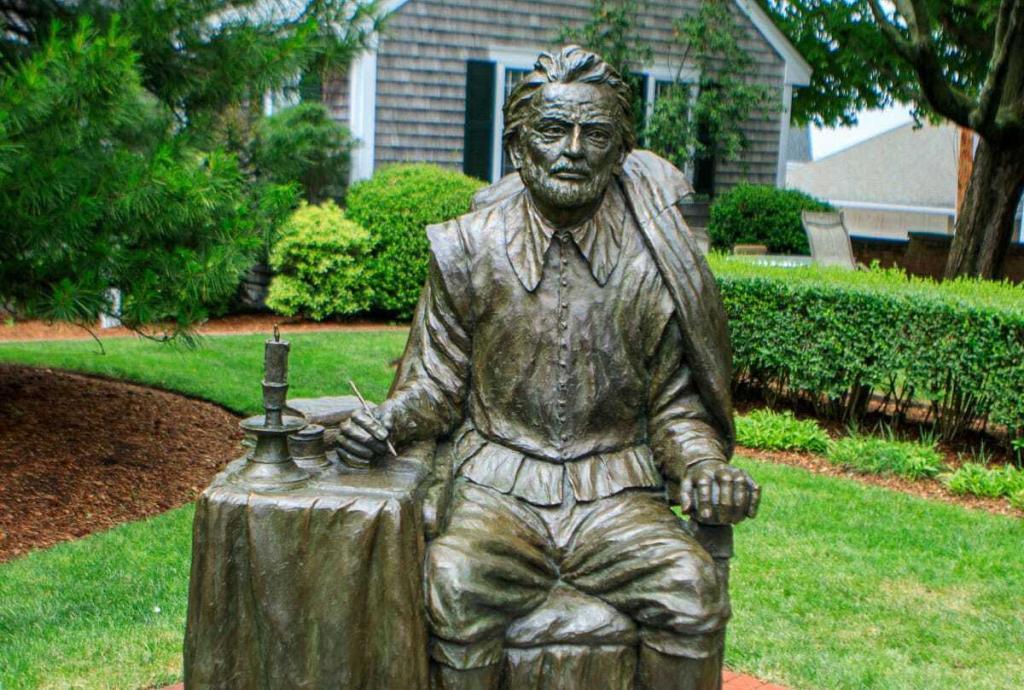The Bradford Family
Passenger Profile
William Bradford and his wife Dorothy traveled on the Mayflower; they made the decision to leave behind their five-year old son, John, behind, and have him come later. Dorothy drowned 7 December 1620, accidentally falling overboard while the ship was anchored off Cape Cod Harbor.
William was the son of William & Alice (Hanson) Bradford, baptized at Austerfield, York, on 19 March 1589/90. He died at Plymouth, 9 May 1657 and was buried on Burial Hill where a monument was placed in 1825. William married 1) at Amsterdam, 10 December 1613, Dorothy May (who was 16 years old); married 2) at Plymouth, 14 August 1623, Alice (Carpenter) Southworth. Alice was born, probably at Wrington, Somerset, circa 1595, the daughter of Alexander Carpenter. She married 1) at Leiden, 28 May 1613, Edward Southworth. Alice died at Plymouth, 26 or 27 March 1670.
William was a signer of the Mayflower Compact in 1620. He received three acres in the 1623 land division, and in the 1627 Cattle Division, is listed with wife “Alles” and children William Jr. and Mercy.
On 16 November 1620, while on an expedition on Cape Cod to find a place to settle, William unexpectedly stepped in a deer trap and up he went, hanging by his foot. It was on a similar trip in December 1620, when Bradford returned to the ship and learned of his wife’s death. On 11 January 1620/21, while at work, William became extremely ill and he was not expected to live. In time, he recovered but he was still so ill in April, that when he was elected Governor for the first time upon the death of their first Governor, John Carver, he requested an Assistant. During the general sickness that swept through Plymouth during their first few winter months, half their numbers died, so William was fortunate he survived.
A fire broke out on 14 January 1620/21 on the roof of the common house, which is where the sick were being taken care of during the general sickness. The damage was repairable, however it was their Governor, John Carver and William who then lay sick who sustained the most loss.
Governor Bradford didn’t expect his second marriage in 1623 to be such a big celebration, it wasn’t their way, however when news got out, the Native Americans came out in style. Massasoit arrived with his queen (one of five wives); four other kings and six score men. They didn’t come empty handed either, but brought three or four deer and a turkey.
William was a driving force in Plymouth, and served as Governor for many years. In the winter of 1657, he became ill, but said that he really didn’t feel that sick, but when spring came, he only worsened. When he died on 9 May 1657, in his 69th year, “he was lamented by all the colonies of New-England, as a common blessing and father to them all.”
Child of William and Dorothy (May) Bradford:
- John Bradford, born at Leiden, circa 1618; died at Norwich, CT, before 21 September 1676; married about 1650 or earlier, Martha Bourne; they had no children.
Children of William and Alice (Carpenter) Southworth:
- William Bradford, was born at Plymouth, 17 June 1624; died there 20 February 1703/04; married 1) soon after 23 April 1650, Alice Richards; they had ten children: John, William, Thomas, Alice, Mercy, Hannah, Melatiah, Samuel, Mary and Sarah Bradford. William married 2) prob. at Norwich, CT, circa 1674, Sarah ( ) Griswold; they had one child: Joseph Bradford. William married 3) at Plymouth, circa 1676, Mary (Wood) Holmes; they had four children: Israel, Ephraim, David and Hezekiah Bradford.
- Mercy Bradford was born at Plymouth, before May 1627; d. probably before 9 May 1657; married at Plymouth, 21 December 1648, Benjamin Vermayes; they had no known children.
- Joseph Bradford was born at Plymouth, circa 1630; he died there, 10 July 1715; married at Hingham, 25 May 1664, Jael Hobart; they had three children: Joseph, Elisha and Peter Bradford.
Sources:
Mayflower Families Through Five Generations, William Bradford, by Ann S. Lainhart and Robert S. Wakefield, vol. 22. Plymouth, 2004.
Mayflower Passenger References, (from contemporary records and scholarly journals), by Susan E. Roser. 2011. pp. 90-129.
Descendants of William Bradford are invited to join the Governor William Bradford Compact.

Material: Fraxinus nigra (Black ash)
Made in Plymouth Colony, 1630-1670
Descended in the Bradford and Hedge families
The list of Governor Bradford’s possessions made at the time of his death in 1657 lists two “great wooden chairs” in the parlor, worth a total of 8 shillings. “Wooden” referred to the seat material so it is very possible that this is one of the two chairs mentioned in the inventory. The chair descended in the Bradford family to the Hedge family, who donated it to the museum in 1953.
The chair was referred to as William Bradford’s chair as early as 1769, when it was used at ceremonies of the Old Colony Club, a social club of Plymouth men. President Harding sat in the chair at the 1921 Tercentenary Pageant celebrating the 300th anniversary of the Pilgrims’ Landing, investing himself with historical significance. The chair is still used to validate historic occasions. In 1995, Supreme Court Justice David Souter sat in Pilgrim Hall’s reproduction of the chair at the 375th anniversary celebration in which 175 new American citizens were naturalized.
The chair has been restored and has lost about three inches in height. The hand grips are missing. The top crest rail and board seat have been replaced, and several spindles are not original. While the chair has been coated with brown varnish, faint traces of black paint can be seen under the seat rails.

